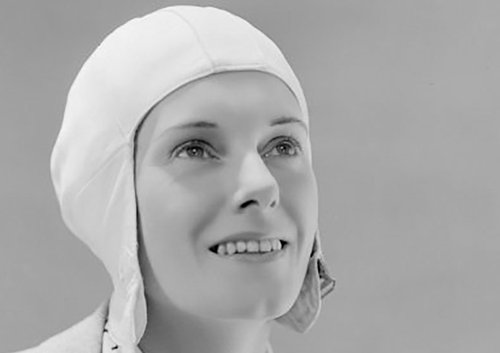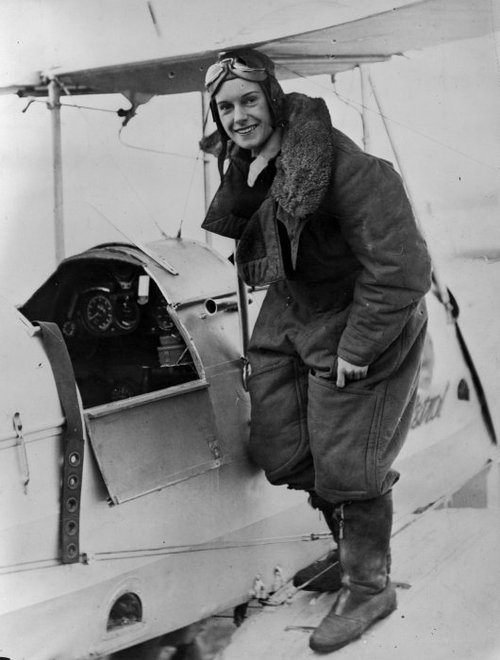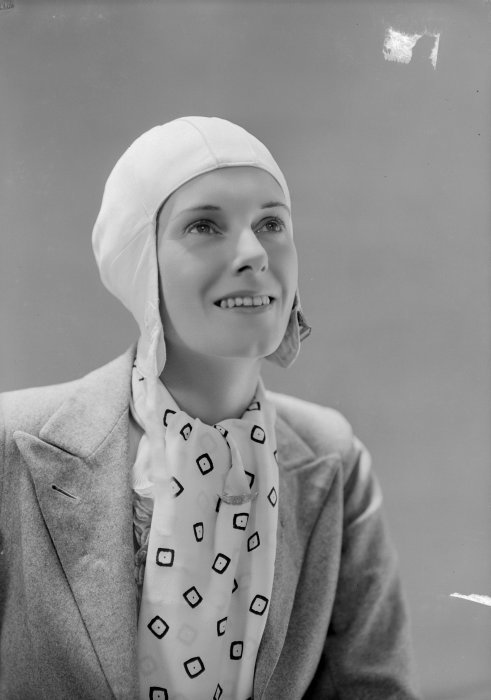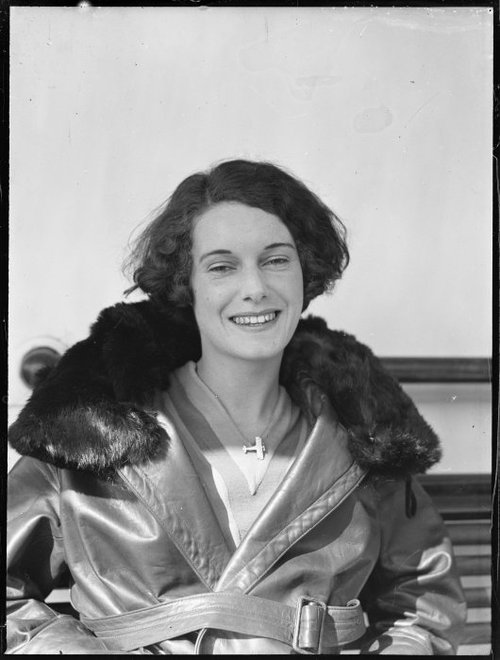
By Sarah Johnston (Ngā Taonga Sound & Vision)
Her arrival at Auckland’s Mangere Aerodrome in her Percival Gull aeroplane was captured by radio station 1YA in a series of remarkable live broadcast recordings held in the RNZ historic collection at Ngā Taonga Sound & Vision.

Jean Gardner Batten. “New Zealand Free Lance”. (Photographic prints and negatives. Ref: 1/2-046051-F. Alexander Turnbull Library, Wellington, New Zealand. http://natlib.govt.nz/records/22671195)
Jean was already famous for her successful solo flights from England to Australia in May 1934, and to South America in November 1935, so a large crowd had gathered to welcome her. The unidentified radio announcer describes the approach of her plane, with sightings already reported by observers in New Plymouth, Mokau and Kaipara as she approached Auckland from Sydney. The journey had started in Folkestone, England on the 5th of October and she had already broken the previous UK-Australia record by arriving in Sydney one week later.
The audio, which was captured on a series of 12-inch acetate discs, is faint and crackly and almost inaudible in places. Considering the National Broadcasting Service had only acquired disc-recording equipment the previous year, it would have been quite a technical feat to record the commentary and welcome as they were broadcast live “on relay” from the aerodrome.

Jean Gardner Batten. Burt, Gordon Onslow Hilbury, 1893-1968. (Negatives. Ref: 1/2-037061-F. Alexander Turnbull Library, Wellington, New Zealand. http://natlib.govt.nz/records/23081536)
“Here she is, here she is…a beautiful three-point landing”
Other aircraft from the Auckland Aero Club flew out to meet her and escort her in. “Here she is, here she is…a beautiful three-point landing,” exclaims the announcer, a note of relief in his voice, to cheers from the large crowd and engine noise from her aircraft in the background. As the plane taxis past him he notes, “Her father can’t be restrained any longer and runs out to meet her… Mounted police are keeping the crowd back.”
“Jean, you’re a very naughty girl…”
As Jean Batten steps from her cockpit, the cheers intensify. Always publicity-conscious, Miss Batten must have cut a glamorous figure for the “swarming photographers,” as can be seen from these images.

Portrait of Jean Batten. Whites Aviation Ltd. (Photographs. Ref: WA-AVP-23-1-G. Alexander Turnbull Library, Wellington, New Zealand. http://natlib.govt.nz/records/23101182)
The official party which welcomed her with a series of speeches, included the Mayor of Auckland Ernest Davis. He congratulates her on her “wonderful achievement,” but jokes (rather patronisingly): “Jean, you’re a very naughty girl, and really I think you want a good spanking for giving us such an anxious time.”
The Minister of Defence Frederick Jones, then welcomes her on behalf of the Prime Minister Michael Joseph Savage, saying: “Jean Batten and Jack Lovelock are the two of the greatest sports in the world today and have brought credit to this Dominion of ours.”
Ellen Melville, pioneering feminist, solicitor, city councillor and President of the National Council of Women expresses pride, admiration and affection on behalf of the women of New Zealand and describes the anxiety with which they have followed Miss Batten’s flight.
“Three cheers for Miss Batten”
Finally Jean herself speaks and describes her flight to the crowd, ending, “This is without doubt the very greatest moment of my life.” An unidentified man calls “Three cheers for Miss Batten” and the crowd sings “For She’s a Jolly Good Fellow,” while she is presented with flowers by college girls, with their heroine standing on a chair so the crowd can see her.
This series of recordings ends with a studio talk by Jean Batten from station 1YA, broadcast that evening nationwide and apparently also via shortwave to audiences in Australia and England. You can listen to this broadcast here.
Because it was recorded in studio, the sound quality is considerably better than the aerodrome audio. She gives a detailed description of her flight, saying she could hear the roar of the Auckland crowd when she landed, even over the sound of the engines.
Radio audiences of 1936 must have been captivated by the images she describes, flying through storms and hurricanes over exotic locations such as Burma, Siam and Java. Aerodromes on her flight path were lit up to guide her and she thanks all those who helped her complete the journey. She tells her audience she is very proud that New Zealand, “the farthest-flung Dominion, is now linked to Great Britain by flight,” and hopes her flight will be the forerunner of an airmail service between the two countries.